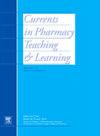Pharmacy faculty and students perceptions of artificial intelligence: A National Survey
IF 1.4
Q3 EDUCATION, SCIENTIFIC DISCIPLINES
引用次数: 0
Abstract
Introduction
This study explores the perceptions, familiarity, and utilization of artificial intelligence (AI) among pharmacy faculty and students across the United States. By identifying key gaps in AI education and training, it highlights the need for structured curricular integration to prepare future pharmacists for an evolving digital healthcare landscape.
Methods
A 19-item Qualtrics™ survey was created to assess perceptions of AI use among pharmacy faculty and students and distributed utilizing publicly available contacts at schools of pharmacy and intern lists. The electronic survey was open from September 5th to November 22nd 2023. Responses were analyzed for trends and compared between faculty and student responses across four sub-domains.
Results
A total of 235 pharmacy faculty and 405 pharmacy students completed the survey. Responses indicated high familiarity with AI in both groups but found differences in training. Both groups identified ethical considerations and training as major barriers to AI integration. Faculty were less likely to trust AI responses than students despite reporting similar rates of incorrect information. Students were more concerned than faculty about AI reducing pharmacy jobs, particularly in community and health-system settings.
Discussion
This study highlights the need for intentional AI training tailored to pharmacy students, aiming to bridge the knowledge gap and equip them with the skills to navigate an AI-driven future. The inconsistency in how AI is addressed within the curriculum and the lack of established ethical guidelines display the need for clear and consistent institutional policies and professional guidance.
药学教师和学生对人工智能的看法:一项全国调查
本研究探讨了美国药学教职员工和学生对人工智能(AI)的认知、熟悉度和使用情况。通过确定人工智能教育和培训中的关键差距,它强调了结构化课程整合的必要性,以使未来的药剂师为不断发展的数字医疗环境做好准备。方法创建了一项包含19个项目的qualics™调查,以评估药学教师和学生对人工智能使用的看法,并利用药学学校的公开联系人和实习生名单进行分发。电子调查开放时间为2023年9月5日至11月22日。我们分析了四个子领域的反馈趋势,并比较了教师和学生的反馈。结果共有235名药学专业教师和405名药学专业学生完成调查。回答表明,两组人对人工智能都非常熟悉,但在训练方面存在差异。两组人都认为道德考虑和培训是人工智能整合的主要障碍。与学生相比,教师更不可能相信人工智能的回答,尽管报告的错误信息比例相似。学生比教师更担心人工智能会减少药房的工作,尤其是在社区和卫生系统环境中。本研究强调了为药学学生量身定制的人工智能培训的必要性,旨在弥合知识差距,并为他们提供驾驭人工智能驱动的未来的技能。人工智能在课程中如何处理的不一致以及缺乏既定的道德准则表明需要明确和一致的机构政策和专业指导。
本文章由计算机程序翻译,如有差异,请以英文原文为准。
求助全文
约1分钟内获得全文
求助全文
来源期刊

Currents in Pharmacy Teaching and Learning
EDUCATION, SCIENTIFIC DISCIPLINES-
CiteScore
2.10
自引率
16.70%
发文量
192
 求助内容:
求助内容: 应助结果提醒方式:
应助结果提醒方式:


